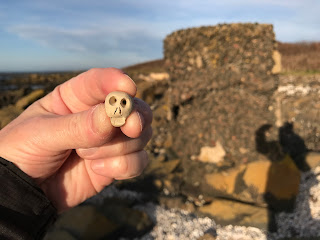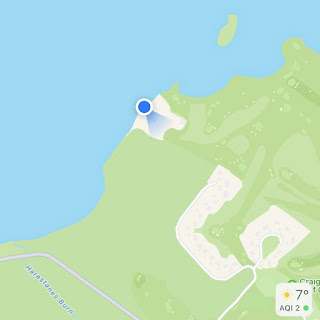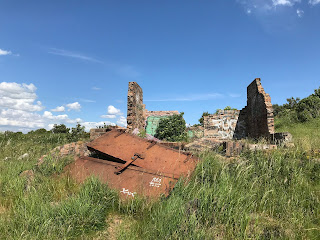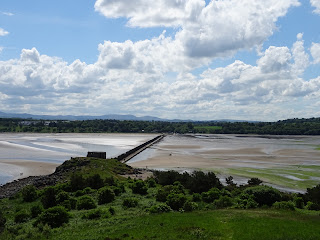On a sunny, but very windy day, I took
the train out to Aberdour and then walked along the Fife Coastal Path towards
Dalgety Bay. The path wound its way
through woods where birds chirped, insects buzzed, and everything swayed
slightly in the stiff breeze. The path then
led me through a field, where I ended up by Braefoot Terminal. A rather charming looking area of high fences
and security where liquefied petroleum gas is stored and pumped out into the large
tankers that dock there. Following a
path by one of the security fences I made my way into Braefoot Plantation,
where the remains of Braefoot Battery lie.
Braefoot Battery was a First World War
coastal defence site that overlooked the Firth of Forth. In early 1914, just shortly before the start
of the war, the government bought the land the battery now sits on from the
Earl of Moray. It would seem however,
that there had been plans for quite some time to build a battery there in
preparation for any attack by enemy forces on the UK. Construction then began with the battery
being completed in 1915. When finished
it had two 9.2 inch guns, which could fire a shell weighing 55kg a distance of
up to 26KM. These large calibre guns were
intended for use on enemy ships that may come into the Forth to attack either ships
anchored there or the naval base at Rosyth.
In 1917 the defence of the Forth was
restructured and the guns at the Braefoot Battery were no longer needed
there. They were dismounted and put into
storage, with one gun later being sent to Portsmouth. The site was again used in WWII and several
new buildings were added.
A post war woodland plantation now grows
all around the battery buildings and though this gave my walk a lovely woodland
feel, the trees did obscure what once must have been quite spectacular views
from the hill the battery is on.
After walking around the woods, I made my
way down to the nearby shore. Like almost
everywhere along the coast of the Forth, probably the whole coast of Britain,
there is a rather tragic story connected to this place. A tale so horribly tragic that I just have to
tell it...
...in 1887, on a sunny afternoon in
mid-May, James Turnbull, a solicitor who lived in Aberdour, decided it would the
perfect sort of day to sail out in his boat.
The perfect sort of day to get a good view of the construction work
going on in the building of the Forth Bridge.
So, he invited his chief clerk, a Mr Ramsay, to comer along with him on
this little jaunt. The two men set sail and
the weather was quite lovely, just until they got to Braefoot Point where a
sudden squall caught them. The small
boat they were in was not built for these sorts of choppy waters and high waves,
and it soon filled with water and began to sink. The two men, both of whom were unable to
swim, stood on the deck of the boat as the water first reached up around their
ankles, and then up around their waists.
But behold, a passing steamer.
The two men on seeing the ship waved and shouted at it, hoping to be
rescued. On the deck of the steamer, the
passengers thought they were seeing two bathers in the water waving as they
went past. So, they waved back, and the
ship steamed on. As the water reached up
to their necks, both Turnbull and Ramsay realised they were doomed. They said a little prayer, then their
goodbyes to each other before the sea swallowed them up. Now, on the steamer it so happened that three
of the passengers who had been waving to the doomed men were none other than
Turnbull’s daughters. On their arrival home
they excitedly chattered to their mother about their trip on the ship and
having seen some bathers at Braefoot Point.
A friend of Turnbull’s was waiting in the house to see him and realising
that he was not the most accomplished of sailors, had become concerned about
how long it was taking for him to return.
On hearing the girls talk he had a sudden horrible realisation of what
they might have in fact seen. He quickly
summoned some men, and they made their way to Braefoot Point. There they found Turnbull’s boat washed up on
the shore. Shortly afterwards, as the
tide went out, they found the bodies of both Turnbull and Ramsay. Two
men who quite literally had been not waving but drowning.
On the shore at Braefoot Point there
stands an old pier. I made my way out
onto it and the wind, which had been getting up all day, battered me this way
and that, making it difficult to even keep my balance. The sea was rough, being whipped up by the
wind and I understood how it could easily overwhelm a small boat like that which
Turnbull and Ramsay had been sailing. Feeling
decidedly unsafe, despite being on dry land, I quickly made my way back and
walked over to one of the battery pill boxes, which stood out on the rocks overlooking the Forth.
There, in a howling gale, I left the
Skulferatu that had accompanied me on my walk in a hole in the wall.
The coordinates for the location of the
Skulferatu are –
Latitude 56.034242
Longitude -3.321253
what3words: throat.points.loved
I used the following sources for
information on Braefoot Battery and Braefoot Point –
Dundee Courier -
Saturday 14 May 1887
Manchester Courier and
Lancashire General Advertiser - Monday 20 April 1914
Canmore
Canmore - Forth
Defences, Middle, Braefoot Point Battery
.jpg)
.jpg)
.jpg)
.jpg)
.jpg)
.jpg)
.jpg)
.JPG)
.JPG)
.jpg)
.jpg)
.jpg)
.jpg)
.jpg)
.jpg)
.jpg)
.JPG)
.jpg)
.jpg)
.JPG)
.jpg)
.JPG)
.jpg)
.jpg)
.JPG)
.jpg)
.jpg)
.jpg)



































